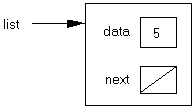
C++ Lesson 32: Linked Lists
INTRODUCTION: In this lesson you begin to study dynamic data structures linked together with pointers. We will start out with a complete example program, then you will complete a lab exercise to practice what you have learned.
The key topics for this lesson are:
A. Declarations for a Linked List
B. Building a Linked List - function insert
C. Using struct Constructors
D. Traversing a Linked List - function printList
E. Pitfalls of Linked Data Structures
F. Value vs. Reference Parameters with Pointers
VOCABULARY:
NODE
LINKED LIST
TRAVERSE
DISCUSSION: A. Declarations for a Linked List
1. A single pointer variable by itself is rather useless. However a self-referencing structure will allow us to create a linked data structure.
struct listNode
{
int data;
listNode *next;
};
2. The declaration seems circular and in some ways it is, but the compiler will allow such definitions. A listNode will have two data members, an integer and a pointer. The pointer variable next will point to the next listNode in a linked list.
3. We can now declare pointer variables which point to a listNode.
listNode *list;
The pointer variable list will eventually hold an address of where a listNode is stored in memory.
4. The following short program using listNode will illustrate the syntax of accessing the data members of a listNode via a pointer.
Program 32-1
#include <iostream.h>
struct listNode
{
int data;
listNode *next;
};
{
listNode *list;
(*list).data = 5;
(*list).next = NULL;
}
This results in this type of memory allocation
and data storage.

5. The statement (*list).data = 5; needs some explanation. The variable list is a pointer variable, the expression (*list) dereferences list - we are about to work with the memory location stored in list. The dot notation (.data) means that we wish to work with the value data inside of the location pointed to by list. The parentheses are needed because the dot operator has priority over the dereferencing operator. If you leave out the parentheses, the expression *list.data, would attempt to dereference list.data, which is not a pointer but simply an integer value.
The member selection operator will be used
throughout the rest of the curriculum guide.
7.
The result of program 32-1 is a pointer (list)
which points to a single structure.
The next
field inside of the node does not point anywhere.
If we use the next
field to link nodes together, we will have a data
structure called a linked list. The next section will walk you
through the construction of a simple linked list.
8.
C++ provides a typedef
statement which enables us to make an alias of a data
type. This
will allow us to write more compact variable
declarations and parameter lists.
typedef
listNode
*listPtr;
The identifier listPtr
is an alias for listNode
*. In Program 32-1, the statement,
listNode
*list; could be replaced
with
listPtr
list;
The variable list
is of type listPtr, which really is an alias type for listNode*.
|
See Handout H.A.32.1, listDemo.cpp. |
1. An example program, which builds a linked list with 5 nodes, is provided as Handout H.A.32.1, listDemo.cpp. Section B of the student outline will refer to the left-hand program on Handout H.A.32.1, (the version without a struct constructor). The source of the data is the for loop inside function createList. |
2. The appearance of the final version of the linked list is:

4. When the first call of insert is made, root is NULL and value equals 1. The following two lines results in the allocation of memory and the assignment of 1 to the data field of newNode.
newNode->data = value;
These two steps can be described as packaging
the node.

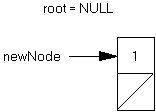
The next line updates the value of root
from NULL to the address stored in newNode.
root
= newNode;
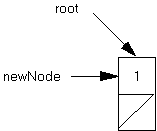
6.
When the function ends, the local identifier, newNode,
is destroyed. Because
root was
passed as a reference parameter, the pointer first
in function main
now points to a new memory location instead of the NULL
value it had before the first call of function insert.

7. The
second call of function insert
receives root pointing
to the list above and the integer value 2.
A newNode is allocated, the 2 is placed
inside the node, and the first pointer hookup produces
this diagram
newNode->data = value;
newNode->next
= root;
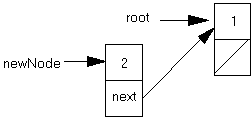
then, root = newNode;
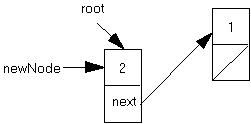
8.
The insert
function terminates and the pointer variable first
(in function main)
points to the newly added node in the list, which in
turn points to the next node.

C.
Using struct
Constructors
|
1. C++ provides for struct constructors which will shorten the code in dynamic data structure programs. Handout H.A.32.1, listDemo.cpp, has a parallel program for listDemo.cpp using a struct constructor. |
2.
The struct
constructor interface is written inside of the struct
declaration area.
The actual code for the constructor is placed
outside of the struct declaration, hence the need for
the scope resolution operator.
struct listNode
{
int data;
listNode *next;
listNode(int, listNode *);
};
: data(tempData), next(tempNext)
{
// all values initialized in initializer list
}
The name of the struct
constructor must match the identifier which names the struct.
The parameters tempData and tempNext
will be assigned to the data fields of a newly
constructed node.
Notice the use of an initializer list instead of
direct assignment statements.
3.
The insert
function is no longer needed in this version and the createList
function uses the struct
constructor.
void createList (nodePtr &root)
{
root = NULL;
for (int k=1; k<=5; k++)
root = new listNode (k, root);
}
4.
The statement
listNode (k,
root) invokes
the struct constructor.
The line of code
root =
new listNode
(k, root);
is broken down as follows:
a. The new command allocates enough memory to store a listNode.
b. The new listNode will be assigned the values of k and root.
c. The address of this newly constructed listNode is assigned to root.
d.
It is important to understand the old and new
values of root:
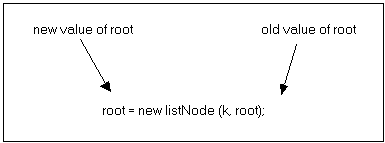
5. When k = 1, root = NULL. A new node is constructed with the values 1 and NULL. This new node is pointed to by root. In a sense, the struct constructor provides a new node between the variable root and the node which root used to point to.
|
|
before the call of the constructor call the constructor, root is passed as a NULL value root is changed, points to the newly constructed node |
6.
When k
= 2, root is already pointing to the first node
of the linked list.
When the constructor is called, the new node is
constructed and placed between root
and the node root
used to point to.

D.
Traversing a Linked List - function printList
1.
To traverse a list means to start at one end and
visit all the nodes, solving a problem along the way.
In the case of function printList,
the task is to print the data
field from each node.
void printList (nodePtr temp)
{
while (temp != NULL)
{
cout << temp->data << " ";
temp = temp->next;
}
cout << endl;
}
a. Because temp is passed as a value parameter, we can use it to traverse the list. The pointer temp will contain NULL when we are done. Since it is not an alias, we protect the value of first in function main.
b. Until temp equals NULL, the while loop will do two steps at each node, print the data field, then advance the temp pointer.
c.
The statement, temp
= temp->next, is a very important one as
this is how we move a pointer to the next node.
The following diagrams with addresses illustrate
this key statement.
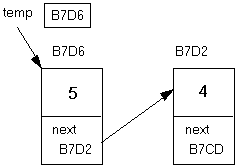
The pointer temp
is storing (pointing at) address B7D6.
The assignment statement, temp
= temp->next, assigns the address B7D2
(the value of temp->next)
to temp.
In other words, whatever node temp
is pointing at, it now stores the address inside of
that node's next field.
The diagram now changes to:
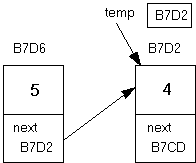
d.
This loop will continue until temp
equals NULL.
2. Another common list traversal problem is counting the number of nodes in the list. The lab exercise will ask you to solve this problem.
E. Pitfalls of Linked Data Structures
{
nodePtr local;
local = temp;
{
cout << local->data << " ";
local = local->next;
}
cout << endl;
}
F. Value vs. Reference Parameters with Pointers
{
... initialize list pointed to by first
changeFirstNode (first);
return 0;
}
void changeFirstNode (listPtr temp)
// changes data field of the first node to zero
{
temp->data = 0;
}
When this function has completed and program control returns to function main, the location first points to has not changed. However the contents of the memory location it points to have been changed.
// changes all data fields to zero
{
while (temp != NULL)
{
temp->data = 0;
temp = temp->next;
}
}
4. Lastly, a pointer passed as a reference parameter can have its contents changed as well as the contents of the location it points to. Predict the effect of this function:
void zeroList (listPtr &temp)
// changes all data fields to zero and ???
{
while (temp != NULL)
{
temp->data = 0;
temp = temp->next;
}
}
SUMMARY/REVIEW:
You have just been taught your first dynamic
data structure, a linked list.
The concept of indirection makes learning
pointers a bit more difficult, but careful reading and
lots of diagrams will help. Following a working program is a
good start; but only by writing code will you develop
proficiency with pointers. The lab exercises for the next few
lessons will test your understanding of pointers.
ASSIGNMENT:
Lab
Exercise L.A.32.1, List1
Answer to the last section in the student outline: All the nodes in the linked list now have the value 0. More importantly, the original pointer passed as a parameter to this function now points to NULL. This is not good.